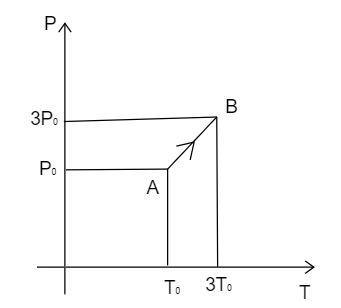Answer
35.4k+ views
Hint Use the formula of the ideal gas equation, substitute the relation between the volume and the density in it. Solving it provides the value of the density. Find the same for the point $A$ and $B$ by substituting the temperature and the pressure at them.
Useful formul
(1) The formula of the ideal gas equation is given by
$PV = nRT$
Where $P$ is the pressure, $V$ is the volume, $n$ is the number of moles, $R$ is the gas constant and $T$ is the temperature.
(2) The relation between the two volume and the molar mass is given by
$\dfrac{n}{V} = \dfrac{d}{M}$
Where $d$ is the density of the gas and $M$ is the molar mass of the gas.
Complete step by step solution
Observe the diagram and analyze the value of the pressure and the temperature in the point $A$ and $B$ .
Let us write the ideal gas equation,
$PV = nRT$
Bring the volume to the right hand side of the equation, we get
$P = \dfrac{{nRT}}{V}$
Substituting the relation (2) in the above equation, we get
$P = \dfrac{d}{M}RT$
The density of the gas is found as
$d = \dfrac{{PM}}{{RT}}$ ------------(1)
Substituting the value of the temperature and the pressure at a point $A$,
$d = \dfrac{{{P_A}M}}{{R{T_A}}}$
Substituting the values,
${\rho _0} = \dfrac{{{P_0}M}}{{R{T_0}}}$ --------------(2)
Substituting the (1) with the value of the temperature and the pressure at a point $B$ ,
$d = \dfrac{{{P_B}M}}{{R{T_B}}}$
${d_B} = \dfrac{{3{P_0}M}}{{R2{T_0}}} = \dfrac{3}{2}{\rho _0}$ ---------------(3)
Thus the option (B) is correct.
Note Ideal gas equation is also known as the equation of the states, because this equation uses the variables in it to determine or explain about the state of the gas that is considered. This is mainly used to interconvert the volume with the molar mass.
Useful formul
(1) The formula of the ideal gas equation is given by
$PV = nRT$
Where $P$ is the pressure, $V$ is the volume, $n$ is the number of moles, $R$ is the gas constant and $T$ is the temperature.
(2) The relation between the two volume and the molar mass is given by
$\dfrac{n}{V} = \dfrac{d}{M}$
Where $d$ is the density of the gas and $M$ is the molar mass of the gas.
Complete step by step solution
Observe the diagram and analyze the value of the pressure and the temperature in the point $A$ and $B$ .
Let us write the ideal gas equation,
$PV = nRT$
Bring the volume to the right hand side of the equation, we get
$P = \dfrac{{nRT}}{V}$
Substituting the relation (2) in the above equation, we get
$P = \dfrac{d}{M}RT$
The density of the gas is found as
$d = \dfrac{{PM}}{{RT}}$ ------------(1)
Substituting the value of the temperature and the pressure at a point $A$,
$d = \dfrac{{{P_A}M}}{{R{T_A}}}$
Substituting the values,
${\rho _0} = \dfrac{{{P_0}M}}{{R{T_0}}}$ --------------(2)
Substituting the (1) with the value of the temperature and the pressure at a point $B$ ,
$d = \dfrac{{{P_B}M}}{{R{T_B}}}$
${d_B} = \dfrac{{3{P_0}M}}{{R2{T_0}}} = \dfrac{3}{2}{\rho _0}$ ---------------(3)
Thus the option (B) is correct.
Note Ideal gas equation is also known as the equation of the states, because this equation uses the variables in it to determine or explain about the state of the gas that is considered. This is mainly used to interconvert the volume with the molar mass.
Recently Updated Pages
To get a maximum current in an external resistance class 1 physics JEE_Main

f a body travels with constant acceleration which of class 1 physics JEE_Main

A hollow sphere of mass M and radius R is rotating class 1 physics JEE_Main

If the beams of electrons and protons move parallel class 1 physics JEE_Main

Two radioactive nuclei P and Q in a given sample decay class 1 physics JEE_Main

If a wire of resistance R is stretched to double of class 12 physics JEE_Main

Other Pages
Oxidation state of S in H2S2O8 is A 6 B 7 C +8 D 0 class 12 chemistry JEE_Main

Two identical charged spheres suspended from a common class 12 physics JEE_Main

Differentiate between homogeneous and heterogeneous class 12 chemistry JEE_Main

Explain the construction and working of a GeigerMuller class 12 physics JEE_Main

In a CO molecule the distance between C mass12 amu class 12 physics JEE_Main

A gas is compressed isothermally to half its initial class 11 physics JEE_Main




